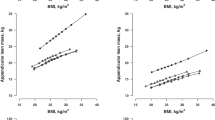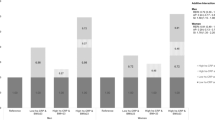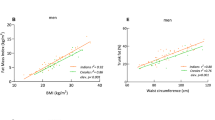Abstract
Objective:
Diabetes in Asia constitutes approximately half of the global burden. Although insulin resistance and incidence of type 2 diabetes differ substantially between ethnic groups within Asia, the reasons for these differences are poorly understood. We evaluated to what extent body fatness, adiponectin levels and inflammation mediate the relationship between ethnicity and insulin resistance in an Asian setting.
Design:
Cross-sectional population-based study.
Subjects:
In total, 4136 adult Chinese, Malays and Asian Indians residing in Singapore.
Measurements:
Insulin resistance was assessed using homeostasis model assessment (HOMA-IR) and systemic inflammation by C-reactive protein (CRP). Data were analyzed using path analysis.
Results:
HOMA-IR was highest in Asian Indians, intermediate in Malays and lowest in Chinese (P<0.001). The difference in HOMA-IR between Malays and Chinese disappeared after adjusting for body mass index (BMI). For the comparison of Asian Indians with Chinese, the association between ethnicity and HOMA-IR was mediated by BMI (men: 32.9%; women: 48.5%), BMI-adjusted waist circumference (men: 6.1%; women: 3.5%), and CRP (men: 5.1%; women: 5.6%), and unidentified factors (men: 47.2%; women: 26.5%). Part of the mediating effects of body fatness was indirect through effects of body fatness on CRP and adiponectin concentrations.
Conclusion:
Mediators of ethnic differences in insulin resistance differed markedly depending on the ethnic groups compared. General adiposity explained the difference in insulin resistance between Chinese and Malays, whereas abdominal fat distribution, inflammation and unexplained factors contributed to excess insulin resistance in Asian Indians as compared with Chinese and Malays. These findings suggest that interventions targeting excess weight gain can reduce ethnic disparities in insulin resistance among Asian Indians, Chinese and Malays.
This is a preview of subscription content, access via your institution
Access options
Subscribe to this journal
Receive 12 print issues and online access
$259.00 per year
only $21.58 per issue
Buy this article
- Purchase on Springer Link
- Instant access to full article PDF
Prices may be subject to local taxes which are calculated during checkout

Similar content being viewed by others
References
International Diabetes Federation. IDF Diabetes Atlas. International Diabetes Federation: Brussels, Belgium, 2009.
Bhalla V, Fong CW, Chew SK, Satku K . Changes in the levels of major cardiovascular risk factors in the multi-ethnic population in Singapore after 12 years of a national non-communicable disease intervention programme. Singapore Med J 2006; 47: 841–850.
Mente A, Razak F, Blankenberg S, Vuksan V, Davis AD, Miller R et al. Ethnic variation in adiponectin and leptin levels and their association with adiposity and insulin resistance. Diabetes Care 2010; 33: 1629–1634.
Martin M, Palaniappan LP, Kwan AC, Reaven GM, Reaven PD . Ethnic differences in the relationship between adiponectin and insulin sensitivity in South Asian and Caucasian women. Diabetes Care 2008; 31: 798–801.
Hughes K, Aw TC, Kuperan P, Choo M . Central obesity, insulin resistance, syndrome X, lipoprotein(a), and cardiovascular risk in Indians, Malays, and Chinese in Singapore. J Epidemiol Community Health 1997; 51: 394–399.
McKeigue PM, Shah B, Marmot MG . Relation of central obesity and insulin resistance with high diabetes prevalence and cardiovascular risk in South Asians. Lancet 1991; 337: 382–386.
Deurenberg-Yap M, Schmidt G, van Staveren WA, Deurenberg P . The paradox of low body mass index and high body fat percentage among Chinese, Malays and Indians in Singapore. Int J Obes Relat Metab Disord 2000; 24: 1011–1017.
Esteve E, Ricart W, Fernandez-Real JM . Adipocytokines and insulin resistance: the possible role of lipocalin-2, retinol binding protein-4, and adiponectin. Diabetes Care 2009; 32 (Suppl 2): S362–S367.
Li S, Shin HJ, Ding EL, van Dam RM . Adiponectin levels and risk of type 2 diabetes: a systematic review and meta-analysis. JAMA 2009; 302: 179–188.
Ndumele CE, Pradhan AD, Ridker PM . Interrelationships between inflammation, C-reactive protein, and insulin resistance. J Cardiometab Syndr 2006; 1: 190–196.
Misra A . C-reactive protein in young individuals: problems and implications for Asian Indians. Nutrition (Burbank, Los Angeles County, CA) 2004; 20: 478–481.
Chambers JC, Kooner JS . Diabetes, insulin resistance and vascular disease among Indian Asians and Europeans. Semin Vasc Med 2002; 2: 199–214.
Tan CE, Emmanuel SC, Tan BY, Jacob E . Prevalence of diabetes and ethnic differences in cardiovascular risk factors. The 1992 Singapore National Health Survey. Diabetes Care 1999; 22: 241–247.
Cutter J, Tan BY, Chew SK . Levels of cardiovascular disease risk factors in Singapore following a national intervention programme. Bull World Health Organ 2001; 79: 908–915.
Matthews DR, Hosker JP, Rudenski AS, Naylor BA, Treacher DF, Turner RC . Homeostasis model assessment: insulin resistance and beta-cell function from fasting plasma glucose and insulin concentrations in man. Diabetologia 1985; 28: 412–419.
Gamborg M, Andersen PK, Baker JL, Budtz-Jørgensen E, Jørgensen T, Jensen G et al. Life course path analysis of birth weight, childhood growth, and adult systolic blood pressure. Am J Epidemiol 2009; 169: 1167–1178.
Chen W, Srinivasan SR, Berenson GS . Path analysis of metabolic syndrome components in black versus white children, adolescents, and adults: the Bogalusa Heart Study. Ann Epidemiol 2008; 18: 85–91.
Arbuckle JL . Amos (Version 18.0) (Computer Program). SPSS: Chicago, 2007.
Hamdy O, Porramatikul S, Al-Ozairi E . Metabolic obesity: the paradox between visceral and subcutaneous fat. Curr Diabetes Rev 2006; 2: 367–373.
Yatagai T, Nagasaka S, Taniguchi A, Fukushima M, Nakamura T, Kuroe A et al. Hypoadiponectinemia is associated with visceral fat accumulation and insulin resistance in Japanese men with type 2 diabetes mellitus. Metabolism Clin Experiment 2003; 52: 1274–1278.
Kwon K, Jung SH, Choi C, Park SH . Reciprocal association between visceral obesity and adiponectin: in healthy premenopausal women. Int J Cardiol 2005; 101: 385–390.
Fujikawa R, Ito C, Nakashima R, Orita Y, Ohashi N . Is there any association between subcutaneous adipose tissue area and plasma total and high molecular weight adiponectin levels? Metabolism 2008; 57: 506–510.
Nakamura Y, Sekikawa A, Kadowaki T, Kadota A, Kadowaki S, Maegawa H et al. Visceral and subcutaneous adiposity and adiponectin in middle-aged Japanese men: the ERA JUMP study. Obesity (Silver Spring, MD) 2009; 17: 1269–1273.
Raji A, Gerhard-Herman MD, Warren M, Silverman SG, Raptopoulos V, Mantzoros CS et al. Insulin resistance and vascular dysfunction in nondiabetic Asian Indians. J Clin Endocrinol Metab 2004; 89: 3965–3972.
Chiu KC, Cohan P, Lee NP, Chuang LM . Insulin sensitivity differs among ethnic groups with a compensatory response in beta-cell function. Diabetes Care 2000; 23: 1353–1358.
Ferris WF, Naran NH, Crowther NJ, Rheeder P, van der Merwe L, Chetty N . The relationship between insulin sensitivity and serum adiponectin levels in three population groups. Horm Metab Res 2005; 37: 695–701.
Lear SA, Kohli S, Bondy GP, Tchernof A, Sniderman AD . Ethnic variation in fat and lean body mass and the association with insulin resistance. J Clin Endocrinol Metab 2009; 94: 4696–4702.
McKeigue PM, Shah B, Marmot MG . Relation of central obesity and insulin resistance with high diabetes prevalence and cardiovascular risk in South Asians. Lancet 1991; 337: 382–386.
Abate N, Chandalia M, Snell PG, Grundy SM . Adipose tissue metabolites and insulin resistance in nondiabetic Asian Indian men. J Clin Endocrinol Metab 2004; 89: 2750–2755.
Chandalia M, Cabo-Chan Jr AV, Devaraj S, Jialal I, Grundy SM, Abate N . Elevated plasma high-sensitivity C-reactive protein concentrations in Asian Indians living in the United States. J Clin Endocrinol Metab 2003; 88: 3773–3776.
Chandalia M, Lin P, Seenivasan T, Livingston EH, Snell PG, Grundy SM et al. Insulin resistance and body fat distribution in South Asian men compared to Caucasian men. PLoS One 2007; 2: e812.
Raji A, Gerhard-Herman MD, Williams JS, O’connor ME, Simonson DC . Effect of pioglitazone on insulin sensitivity, vascular function and cardiovascular inflammatory markers in insulin-resistant non-diabetic Asian Indians. Diabet Med 2006; 23: 537–543.
Deurenberg P, Yap M, van Staveren WA . Body mass index and percent body fat: a meta-analysis among different ethnic groups. Int J Obes Relat Metab Disord 1998; 22: 1164–1171.
Ehtisham S, Crabtree N, Clark P, Shaw N, Barrett T . Ethnic differences in insulin resistance and body composition in United Kingdom adolescents. J Clin Endocrinol Metab 2005; 90: 3963–3969.
Raji A, Seely EW, Arky RA, Simonson DC . Body fat distribution and insulin resistance in healthy Asian Indians and Caucasians. J Clin Endocrinol Metab 2001; 86: 5366–5371.
Valsamakis G, Chetty R, McTernan PG, Al-Daghri NM, Barnett AH, Kumar S . Fasting serum adiponectin concentration is reduced in Indo-Asian subjects and is related to HDL cholesterol. Diabetes Obesity Metabolism 2003; 5: 131–135.
Chambers JC, Eda S, Bassett P, Karim Y, Thompson SG, Gallimore JR et al. C-reactive protein, insulin resistance, central obesity, and coronary heart disease risk in Indian Asians from the United Kingdom compared with European whites. Circulation 2001; 104: 145–150.
Krishnaveni GV, Hill JC, Veena SR, Bhat DS, Wills AK, Karat CL et al. Low plasma vitamin B12 in pregnancy is associated with gestational ‘diabesity’ and later diabetes. Diabetologia 2009; 52: 2350–2358.
Yajnik CS, Deshpande SS, Jackson AA, Refsum H, Rao S, Fisher DJ et al. Vitamin B12 and folate concentrations during pregnancy and insulin resistance in the offspring: the Pune Maternal Nutrition Study. Diabetologia 2008; 51: 29–38.
Torrens JI, Skurnick J, Davidow AL, Korenman SG, Santoro N, Soto-Greene M et al. Ethnic differences in insulin sensitivity and beta-cell function in premenopausal or early perimenopausal women without diabetes: the Study of Women's Health Across the Nation (SWAN). Diabetes Care 2004; 27: 354–361.
Chiu KC, Chuang LM, Yoon C . Comparison of measured and estimated indices of insulin sensitivity and beta cell function: impact of ethnicity on insulin sensitivity and beta cell function in glucose-tolerant and normotensive subjects. J Clin Endocrinol Metab 2001; 86: 1620–1625.
Lee JW, Brancati FL, Yeh HC . Trends in the prevalence of Type 2 diabetes in asians versus whites: results from the United States National Health Interview Survey, 1997–2008. Diabetes Care 2011; 34: 353–357.
Kadowaki T, Sekikawa A, Okamura T, Takamiya T, Kashiwagi A, Zaky WR et al. Higher levels of adiponectin in American than in Japanese men despite obesity. Metabolism 2006; 55: 1561–1563.
Lee S, Jensen MD . Adipogenic risk factor differences between Korean and white adults—potential role of plasma free fatty acid and adiponectin. Metabolism 2009; 58: 270–274.
Dans A, Ng N, Varghese C, Tai ES, Firestone R, Bonita R . The rise of chronic non-communicable diseases in southeast Asia: time for action. Lancet 2011; 377: 680–689.
Katsuki A, Sumida Y, Gabazza EC, Murashima S, Furuta M, Araki-Sasaki R et al. Homeostasis model assessment is a reliable indicator of insulin resistance during follow-up of patients with type 2 diabetes. Diabetes Care 2001; 24: 362–365.
Liew CF, Seah ES, Yeo KP, Lee KO, Wise SD . Lean, nondiabetic Asian Indians have decreased insulin sensitivity and insulin clearance, and raised leptin compared to Caucasians and Chinese subjects. Int J Obes Relat Metab Disord 2003; 27: 784–789.
Menzaghi C, Trischitta V, Doria A . Genetic influences of adiponectin on insulin resistance, type 2 diabetes, and cardiovascular disease. Diabetes 2007; 56: 1198–1209.
Acknowledgements
This study was supported by the Biomedical Research Council (Grant number 03/1/27/18/216) and the National Medical Research Council (Grant numbers 0838/2004 and NMRC/CSI/0002/2005).
Author information
Authors and Affiliations
Corresponding author
Ethics declarations
Competing interests
In the past 2 years, Dr E Shyong Tai has been involved in advisory boards for Bristol Myers Squibb (Singapore) Pte Ltd, Astra Zeneca (Singapore) Pte Ltd. and Novo Nordisk Pharma (Singapore) Pte Ltd. He has also received honoraria as a speaker for Merck Sharp and Dohme (IA) Corp., Unilever and Abbot Laboratories. The remaining authors declare no conflict of interest.
Additional information
Supplementary Information accompanies the paper on International Journal of Obesity website
Rights and permissions
About this article
Cite this article
Gao, H., Salim, A., Lee, J. et al. Can body fat distribution, adiponectin levels and inflammation explain differences in insulin resistance between ethnic Chinese, Malays and Asian Indians?. Int J Obes 36, 1086–1093 (2012). https://doi.org/10.1038/ijo.2011.185
Received:
Revised:
Accepted:
Published:
Issue Date:
DOI: https://doi.org/10.1038/ijo.2011.185
Keywords
This article is cited by
-
Sex differences in the associations between adiposity distribution and cardiometabolic risk factors in overweight or obese individuals: a cross-sectional study
BMC Public Health (2021)
-
Trans-ethnic gut microbial signatures of prediabetic subjects from India and Denmark
Genome Medicine (2021)
-
Interethnic differences in neuroimaging markers and cognition in Asians, a population-based study
Scientific Reports (2020)
-
Use of age-dependent FRAX-based intervention thresholds for Singapore
Archives of Osteoporosis (2020)
-
Waist circumference trajectories and risk of type 2 diabetes mellitus in Korean population: the Korean genome and epidemiology study (KoGES)
BMC Public Health (2019)



